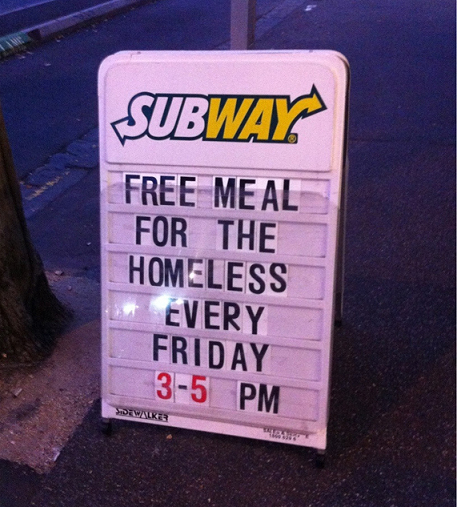A few days ago, I heard someone complaining that all advertisers do is take advantage of consumers by manipulating them. They gain marketshare by telling bigger lies in louder voices than their competitors. But is that what advertising is about? Is that what business is about?
I argue that there is such a thing as truth in advertising. Advertising and lying are two different things in my book.
Moreover, marketing can actually make the world a better place. That’s how it ought to be used.
Taking inspiration from the instant viral hit “21 Pictures That Will Restore Your Faith in Humanity,” I wrote this month’s newsletter on the topic of how doing good is good for business.
Check it out below.
—
Doing good is good for business.
Not everyone believes that. I’ve had several discussions with people who think marketing is inherently evil and that entrepreneurs are generally dishonest and greedy. Maybe you’ve had similar conversations.
As I’m sure you know, you don’t have to be one of the bad guys to be successful in business.
With that in mind, this issue was inspired by the instantly viral article “21 Pictures That Will Restore Your Faith in Humanity.” I normally wouldn’t ask you to stop listening while I’m talking (or reading while I’m typing) but you should strongly consider taking a few minutes to check out that article if you haven’t already done so. It’s just photos and captions, so it’ll only take a moment. Everything I say will make more sense if you do.
Let’s look at 3 instances of altruism in action from the article. Although I’m not sure any of these were meant to be marketing ideas, the insights we gain can have a dramatic impact on your business.
An Amazing First Impression
When you look at the “21 Pictures” article, the caption under this image tells us that the owner of the dry cleaner who put on this “promotion” estimates that it cost $32,000 to help around 2,000 unemployed people in his community.
You know what I call that (other than “nice”)? An irresistible front-end offer.
Dry cleaners provide a service their customers need time after time. If they treat their customers right, they can form lifelong relationships. Free dry cleaning during a time of need is an incredible way to get the ball rolling. Where do you think these people had their suits cleaned in the future? How many other people did they tell about their experience? How much PR did this effort garner?
Think about it like this: this cleaner bought leads for $16 apiece. Last time I went to the dry cleaners, I spent $45. Does that sound like a good investment?
Application:
1) Do you have an irresistible introductory offer? One so good that it’s virtually impossible to turn down?
In a previous newsletter, I mentioned how Gillette sent me a Mach 3 razor in the mail for my 18th birthday. I’ve been happily buying expensive blades from them for over a decade now.
Square (http://www.squareup.com) is giving away free mobile credit card readers. They make a small upfront loss to gain 2.75% of every transaction they process in the future.
Book of the Month Club will give you 4 books for $1, knowing you’re likely to buy plenty of books from them in the future.
2) Have you developed a profitable back-end to capitalize on the flood of leads/buyers coming in? In almost every industry, this is where the real money is made. Your current customers are your most valuable asset. Are you making the most of the opportunity to serve them in a way that’s mutually beneficial and profitable?
3) Are you specific in who you’re targeting with your marketing? Are you offers tailor-made for your ideal customers? This dry cleaner is appealed to a specific audience with a very powerful felt need. He saw a way to make their lives easier and improve their ability to make future purchases (by helping them look good on job interviews).
Serve a Starving Crowd. Literally.
Do you believe that the more you give, the more you get back?
If nothing else, this Subway location is helping people in a way that’s tax deductible. But chances are that plenty of customers notice this sign from day to day. This weekly act of kindness must build a lot of good will. Customers feel good about supporting businesses that are doing good in the community.
It pays off to treat people like human beings instead of walking wallets.
Application:
1) What are you doing to prove that you care? Are you using your talents and resources to meet a real need? Focusing on others rather than obsessively looking at your own business is essential to running a successful business.
A Truly Personal Touch
Personal connection goes a long way in today’s “social economy.” Not only do you want to treat people like people (as mentioned above), but you want to show your own human side, as well. This commercial from Ally Bank illustrates the point wonderfully.
These pictures show the correspondence between a 3-year old and the customer manager at a supermarket. Check out the way the manager responded to the letter. The fact that he responded at all is noteworthy, and he took the time to write a personal letter. Read the language he used. It’s not corporate-speak; it’s perfect for talking to a toddler.
A £3 gift card is a tiny investment to give a little girl an unforgettable experience. You can almost guarantee Sainsbury’s will hold a special place in her heart for the rest of her life (which will probably be a long, long time). Her parents, too.
On top of that, gift cards are notorious for putting extra money in retailers’ pockets. It’s hard to find an exact statistic, but the majority of consumers spend more than gift card is worth. They’d rather spend more than waste any of the cards value.
Application:
1) Are you showing your customers how much you appreciate them? What can you do to improve in that area?
2) Can you add even more personal touches to your marketing? Maybe do one thing per week that’s not automated to add value to your valued customers (or perhaps ones you’d like to “reactivate.”)
3) Do your marketing materials, including your website, show off your personality? Do you seem like a person/group of people or a corporate machine?
4) Is there a way to utlize gift cards or pre-punched reward cards to entice customers to come back and buy from you again?




